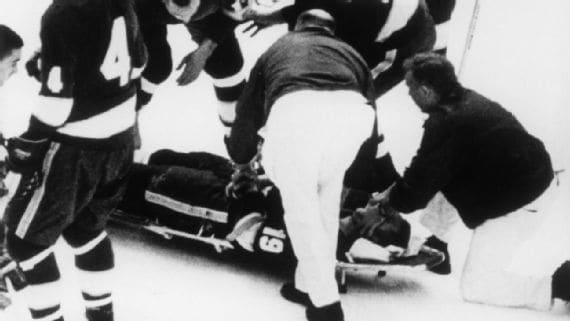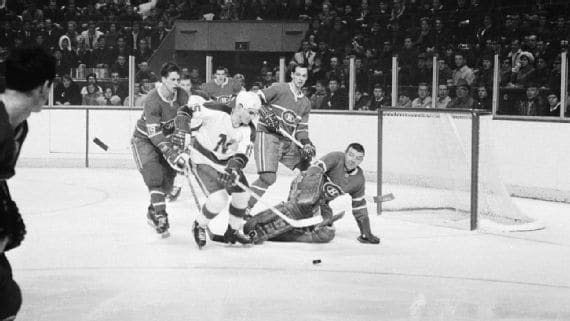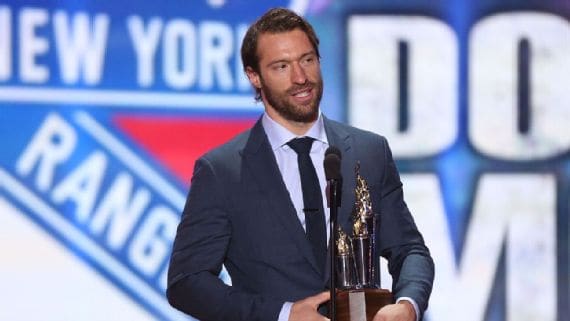On that fatal night at Met Center on Jan. 13, 1968, the Minnesota North Stars center, playing against the Oakland Seals, carried the puck across the blue line and cut to the right while Seals defensemen Larry Cahan and Ron Harris closed in. One of their sticks tangled with Masterton’s skates as he slid a pass to his wing, and he lost his balance, pitching forward. He didn’t see the other defender, who caught him with a clean check that knocked him backward. Masterton, who was not wearing a helmet, smacked the back of his head on the ice. “It sounded like a baseball bat hitting a ball,” teammate André Boudrias recalled.
Ken Lindgren, a fan watching the play about 10 rows up in the stands just above the blue line, can still visualize the impact.
“We watched his head bounce,” Lindgren said. “He didn’t move after that. It got deathly quiet.”
Boudrias helped the team’s trainer onto the ice to tend to Masterton. The team doctor soon joined him. They carried Masterton off on a stretcher, and an ambulance rushed him to Fairview Southdale hospital, seven miles away.
“His eyes were gray at the time — it was like a horror picture,” Boudrias says. “I knew he was done.”
A team of doctors at the hospital treated Masterton with steroids and diuretics, but the swelling in his brain was so swift and severe that they decided against operating.
Realizing he was already gone, Masterton’s parents, who had flown in from Winnipeg after they heard of the incident, and his wife, Carol, made the decision to remove Masterton from life support. At 1:55 a.m. on Jan. 15, 1968 — almost 30 hours after he struck his head on the ice — Bill Masterton died at the age of 29.
Seven hours later, when the Hennepin County medical examiner performed an autopsy, they discovered the true cause of Masterton’s death.
Like many Canadian boys growing up in the ’50s, Masterton listened to Saturday night radio broadcasts of “Hockey Night in Canada” and dreamed of Foster Hewitt making the call: “Masterton shoots, he scores!”
That dream carried him through junior hockey in his hometown of Winnipeg and three years at the University of Denver, where he was an All-American and led the Pioneers to the 1961 NCAA championship, but the dream stalled after two years of minor league hockey in the Montreal Canadiens’ organization. He finished with a master’s degree in business at Denver and landed a job at the Minneapolis-based technology company Honeywell, where he worked in the financial department for the Apollo project, married his high school sweetheart and started a family, adopting a son and a daughter.
The NHL’s expansion from six to 12 teams in 1967-68 rekindled his mothballed dream. He had kept fit by playing on a barnstorming amateur team, the St. Paul Steers, and with the U.S. national team. When Minnesota executives, who had acquired his rights, invited him to a tryout, Masterton relished the second chance. He made the North Stars and scored the first goal in franchise history.
Masterton was not a marquee player, but he was a skilled playmaker who was willing to work in the corners and be a team player. Murray Williamson, who coached both amateur teams Masterton played for, remembered a night in Rochester, Minnesota, when Masterton backed into a radiator in the dressing room and singed his rear end. “He played that game standing up,” Williamson said. “He was a team man off the charts.”
Masterton was soft-spoken and modest, a quiet guy with a good sense of humor. He cherished his son, Scott, 3, and daughter, Sally, 1.
In the week before his last game, Masterton had complained to his wife and several teammates about headaches. He had been checked hard into the glass — less yielding in those days — two weeks earlier in a game against the Boston Bruins. He bore the bruises of that hit and others in subsequent games — on his left arm, both thighs and, unwittingly, his brain.
The night before the Oakland game, Masterton’s family gathered at the house of their neighbor, North Star goaltender Cesare Maniago, to celebrate Maniago’s 29th birthday. Masterton told his friend that he had been having migraines.
Masterton had not told the North Stars’ coach, Wren Blair, about his headaches, but Blair had thought something might be amiss and commented to the team trainer, “I wonder if we could have him checked,” according to the Toronto Star, which first reported this story on May 28, 2011.

Bill Masterton was rushed to hospital after suffering a suspected second concussion in a matter of days. B Bennett/Getty Images
They didn’t. But even if they had, he might still have been in the lineup against Oakland.
“You know the diagnosis of a concussion back in those days?” asked Williamson, who has a photo hanging in his office of Masterton on the stretcher. “You hold out four fingers. If the guy only sees two, you send him back out there because it doesn’t matter anyway.”
Masterton was an unfortunate victim of the ignorance of his time. Even as Walter Bush, one of the North Star owners, saw him lying motionless on the ice, he did not think Masterton had sustained a concussion. “We didn’t really know concussions in those days,” said Bush, now 86. “I’d been knocked out myself playing football. We didn’t think it was that serious.”
Awareness about brain injuries and how to treat them has come a long way since then. So has NHL protocol, initiated in 2011, which has spotters to flag potentially concussed players and bans those from returning to games in which they were injured. But that has not happened fast enough for a group of more than 120 ex-NHL players, including Bernie Nicholls, Mike Peluso and Steve Payne, who are suing the league in a class-action suit for putting their neurological health at risk despite knowing the violent play involved. They and many others claim the league could be doing more to protect its players from returning to action too soon.
Yet players such as Masterton learned to play hurt. That’s what men did. That was the NHL’s code. And in Masterton’s case, it probably cost him his life.
The Hennepin County medical examiner found evidence of a previous injury on the left side of Masterton’s skull on the temporal region of the brain. States the autopsy report: “There was a blow to the left temple in a game some days prior to the fatal injury and the deceased is said to have complained of headaches in the left temporal region.”
When Masterton’s head struck the ice at Met Center, there was no skull fracture, but his brain swelled very quickly, evidenced by his dilated pupils and elevated blood pressure — which pointed to a previous head injury.
“I am convinced he had some type of concussion beforehand,” said Dr. Jesse Corry, a specialist in neurocritical care at the John Nasseff Neuroscience Specialty Clinic in St. Paul who studied the autopsy report. “What killed this man was second-impact syndrome.”
Corry confirmed the opinion of Dr. Charles Tator, a Toronto neurosurgeon quoted in the Toronto Star article, who also said Masterton showed signs of “second-impact syndrome.” When the brain hasn’t healed completely from a previous injury, a subsequent blow can cause the type of sudden and severe swelling found in Masterton’s brain.
Corry does not think the amount of swelling would have been caused from the singular impact at Met Center. Nor did he see evidence of CTE, the progressive degenerative disease found posthumously in the brains of nearly 87 of 91 NFL players who suffered multiple blows to the head. “It is very rare to see that level of swelling in the brain from a single injury,” he said. “[Masterton] probably had some earlier swelling going on, so if he got a second injury, it would be catastrophic.”
The specter of Masterton’s death hung over the NHL All-Star Game, which was played in Toronto the next day, Jan. 16, 1968. Talk centered on the divisive topic of helmets.
Masterton had worn a helmet when he played college hockey in Denver because NCAA regulations required players to wear them, but he did not wear one as a professional. Only a handful of NHL players wore them at the time, including Masterton’s teammate, Boudrias. “You protect your elbows, hips, knees and hands, I figured, why not protect your head?” said Boudrias, now 72.

Andre Boudrias, one of the few players in 1968 to wear a helmet, believes wearing one would have saved Bill Masterton’s life. Denis Brodeur/NHL/Getty Images
It took the NHL more than a decade to catch up to Boudrias’ logic. For the 1979-80 season, the league finally made helmets mandatory for new players — allowing those who signed professional contracts prior to June 1, 1979, the option not to wear them — but it would be 18 years before every NHL player complied.
In 1968, Boudrias was the only North Star who wore a helmet. Typical of the attitude of the day, North Stars coach Wren Blair frowned on the practice. He and others considered it a sign of weakness. They thought it took away from the fan experience, masking the identity of players. “I was asked to take it off,” Boudrias said. “I wouldn’t do it.”
The following season, Blair traded Boudrias, who had scored the second-most points for the team in its first season, citing a drop in his production. Boudrias is convinced his insistence on wearing a helmet factored into Blair’s decision. He’s also convinced a helmet would have saved Masterton’s life.
“There’s no doubt in my mind about that,” Boudrias said.
Yet that might not actually be the case. Since Masterton was off balance at the time he got checked (cleanly; there was no penalty called), his brain twisted inside of his skull before his head struck the ice. That rotation was a contributing factor in the severity of his injury.
“Helmets are great to absorb blunt impact, but when the brain is spinning, helmets don’t help the spinning contents slow down,” Corry said.
A helmet obviously would not have hurt Masterton, but it might not have been enough to spare his life, given the nature of his injury and the fact he had not healed from a recent concussion.

The Bill Masterton Memorial Trophy is awarded to players who show perseverance, courage and sportsmanship. Dominic Moore won the award in 2014. Andre Ringuette/NHLI/Getty Images
“It’s kind of good to hear that because it takes away some of the ‘What if?'” said Masterton’s son, Scott, now 50. “We lived with the accident for many years but did not talk about it.”
After Masterton’s death, the North Stars set up a scholarship fund in his name. The team also retired his No. 19, a tradition the franchise continued to honor when it moved and became the Dallas Stars.
Back at the 1968 All-Star Game, discussion among beat writers went beyond the helmet debate to come up with a way to commemorate the league’s first casualty. The Professional Hockey Writers Association proposed — and the league immediately approved — the Bill Masterton Memorial Trophy to be awarded annually to the player who best exemplifies the virtues of perseverance, courage and sportsmanship that Masterton displayed.
It’s a fine tribute to a respected player who exhibited those virtues himself, but it’s regrettable that it ever came to be. Corry believes Masterton’s death could have been prevented — and would be today.
“When he had headaches early on, we wouldn’t have had him on the ice,” he said.
© John Rosengren
